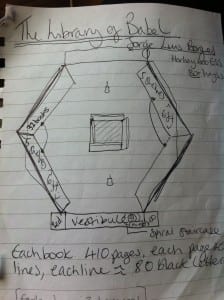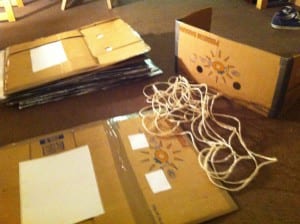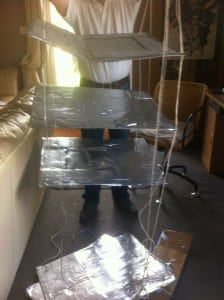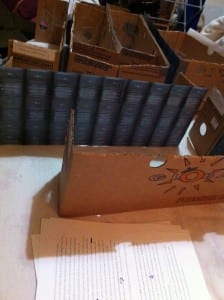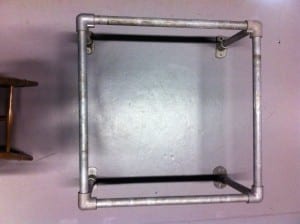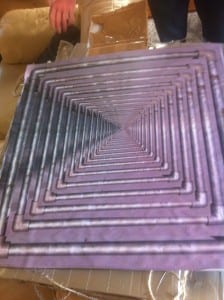- Set
I have already written about wanting to create a room from Borges, The Library of Babel. Here follows the photo documentation of the various aspects of doing so.
This is my initial sketch, made directly from Borges’ story;
To create my own version of this room, I sectioned off the lower part of Studio 2 with the curtains and a row of black flats, in order to create an intimate, enclosed space.
In each corner of this space, I suspended ‘bookshelves’ of sorts; three flat rectangles of cardboard, parallel to the floor, covered in tape and spray-painted silver to create a cold, metallic look – adding to the dystopian feel of the space, hung with, silver spray painted, string from the scaffolding to hover approximately 4 feet from the floor.
On these ‘shelves’ I made cardboard stands with printed images of rows of identical books, I liked the regimented, slightly surreal look of having identical, leather bound, cold blue covers;
To represent the limitlessness of the ‘infinite’ library, the endless continuation of room upon room, I stood a metal frame in the centre of the space, acting as the ‘air shaft’ from Borges’ story, and placed an image of that same frame reducing in size to just a few pixels. I also suspended one of these from the lighting rig, directly above the one on the floor to create the idea that the room in which we all stood was in an undetermined space within the Great Library.
Overall, though the reality of creating this set was at times frustrating, I was happy with the final result. However, I unfortunately do not have any photographic documentation of the final result, as I did not have time to take any pre-show shots, and by the time I had returned from receiving my post-show feedback, half of the set had already been dismantled by the technicians.
- Lighting
I felt that lighting was really important for creating the right atmosphere, from when the audience entered, to representing different portions of my script, to the final blackout.
Firstly, we created a corridor of light that led the audience to the performance area; this decision was made as, although I did want to greet my audience, I wanted to remain in the curtained off space for the entirety of the piece.
The main wash was inspired by Borges’ description of the library’s light being, ‘unceasing and insufficient’; the lights were therefore kept at 30%. I also wanted to be on the same level with my audience for the opening and close of my performance, therefore the light covered the whole space for these sections, including the audience, uniting me with them.
To represent the progressive isolation and deterioration of Bertha’s mental and emotional state, I decided that the Bertha section should begin with a full, front-facing spotlight. This aimed to distinguish the ‘performance’ section from the ‘Natalie talking’ sections. This front spot came down to 70% at the next stage of Bertha’s journey, with an added downward spot at 30%. This aimed to create different shadows and amplify the change in mood. The next point of deterioration triggered a switch to 30% front-facing spot, 70% downward spot, increasing the shadows on my face. For the final point, where Bertha is locked alone in the attic, the front-facing spot was removed completely, with just the downward spot remaining. This meant the shadows on my, or rather Bertha’s, face were dramatically distinguished, the aim of this being to show her depressed and dehumanised state.
For the final scene, the wash lights came back up, reuniting performer and audience. This scene ended with a total blackout as ‘Natalie’ implicitly threw herself down the airshaft.
